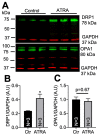All-Trans Retinoic Acid Increases DRP1 Levels and Promotes Mitochondrial Fission
- PMID: 34068960
- PMCID: PMC8156392
- DOI: 10.3390/cells10051202
All-Trans Retinoic Acid Increases DRP1 Levels and Promotes Mitochondrial Fission
Abstract
In the heart, mitochondrial homeostasis is critical for sustaining normal function and optimal responses to metabolic and environmental stressors. Mitochondrial fusion and fission are thought to be necessary for maintaining a robust population of mitochondria, and disruptions in mitochondrial fission and/or fusion can lead to cellular dysfunction. The dynamin-related protein (DRP1) is an important mediator of mitochondrial fission. In this study, we investigated the direct effects of the micronutrient retinoid all-trans retinoic acid (ATRA) on the mitochondrial structure in vivo and in vitro using Western blot, confocal, and transmission electron microscopy, as well as mitochondrial network quantification using stochastic modeling. Our results showed that ATRA increases DRP1 protein levels, increases the localization of DRP1 to mitochondria in isolated mitochondrial preparations. Our results also suggested that ATRA remodels the mitochondrial ultrastructure where the mitochondrial area and perimeter were decreased and the circularity was increased. Microscopically, mitochondrial network remodeling is driven by an increased rate of fission over fusion events in ATRA, as suggested by our numerical modeling. In conclusion, ATRA results in a pharmacologically mediated increase in the DRP1 protein. It also results in the modulation of cardiac mitochondria by promoting fission events, altering the mitochondrial network, and modifying the ultrastructure of mitochondria in the heart.
Keywords: DRP1; all-trans retinoic acid; mitochondrial fission; mitochondrial fusion; mitochondrial network.
Conflict of interest statement
The authors declare no conflict of interest.
Figures






Similar articles
-
Drp1/Fis1 interaction mediates mitochondrial dysfunction in septic cardiomyopathy.J Mol Cell Cardiol. 2019 May;130:160-169. doi: 10.1016/j.yjmcc.2019.04.006. Epub 2019 Apr 11. J Mol Cell Cardiol. 2019. PMID: 30981733 Free PMC article.
-
Melatonin prevents Drp1-mediated mitochondrial fission in diabetic hearts through SIRT1-PGC1α pathway.J Pineal Res. 2018 Sep;65(2):e12491. doi: 10.1111/jpi.12491. Epub 2018 Apr 14. J Pineal Res. 2018. PMID: 29575122 Free PMC article.
-
Adaptor proteins MiD49 and MiD51 can act independently of Mff and Fis1 in Drp1 recruitment and are specific for mitochondrial fission.J Biol Chem. 2013 Sep 20;288(38):27584-27593. doi: 10.1074/jbc.M113.479873. Epub 2013 Aug 6. J Biol Chem. 2013. PMID: 23921378 Free PMC article.
-
[Mechanism of mitochondrial fission - structure and function of Drp1 protein].Postepy Biochem. 2016;62(2):127-137. Postepy Biochem. 2016. PMID: 28132464 Review. Polish.
-
Inhibition of Drp1-dependent mitochondrial fission by natural compounds as a therapeutic strategy for organ injuries.Pharmacol Res. 2023 Feb;188:106672. doi: 10.1016/j.phrs.2023.106672. Epub 2023 Jan 20. Pharmacol Res. 2023. PMID: 36690165 Review.
Cited by
-
Retinoic acid regulates pyruvate dehydrogenase kinase 4 (Pdk4) to modulate fuel utilization in the adult heart: Insights from wild-type and β-carotene 9',10' oxygenase knockout mice.FASEB J. 2022 Sep;36(9):e22513. doi: 10.1096/fj.202101910RR. FASEB J. 2022. PMID: 36004605 Free PMC article.
-
Pivotal role of vitamin D in mitochondrial health, cardiac function, and human reproduction.EXCLI J. 2022 Jul 20;21:967-990. doi: 10.17179/excli2022-4935. eCollection 2022. EXCLI J. 2022. PMID: 36110560 Free PMC article. Review.
-
Mitochondrial Dynamics in Neurodegenerative Diseases: Unraveling the Role of Fusion and Fission Processes.Int J Mol Sci. 2023 Aug 22;24(17):13033. doi: 10.3390/ijms241713033. Int J Mol Sci. 2023. PMID: 37685840 Free PMC article. Review.
-
Intramuscular vitamin A injection in newborn lambs enhances antioxidant capacity and improves meat quality.Front Vet Sci. 2023 Dec 4;10:1272874. doi: 10.3389/fvets.2023.1272874. eCollection 2023. Front Vet Sci. 2023. PMID: 38111737 Free PMC article.
-
Vitamin A and retinoid signaling in the kidneys.Pharmacol Ther. 2023 Aug;248:108481. doi: 10.1016/j.pharmthera.2023.108481. Epub 2023 Jun 17. Pharmacol Ther. 2023. PMID: 37331524 Free PMC article. Review.
References
Publication types
MeSH terms
Substances
Grants and funding
LinkOut - more resources
Full Text Sources
Miscellaneous

